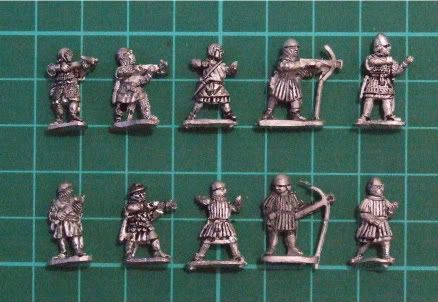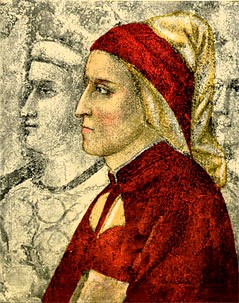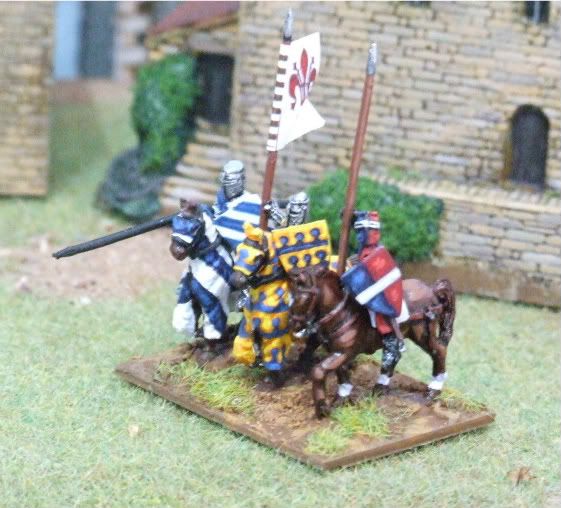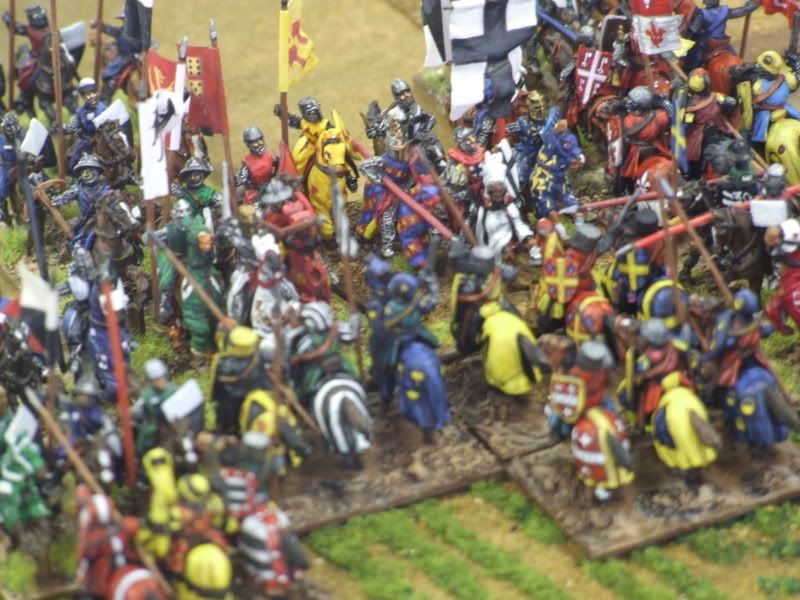
Dante's "
Divine Comedy" features a number of the rulers of the Holy Roman Empire.
Frederick II is shown as a heretic, burning in a tomb on the sixth level of the Inferno. Henry VII was reserved a seat in Paradise. These two are the only ones in this period who were technically emperors, since they had travelled to Rome to be crowned. Henry's journey is shown in a splendid set of pictures made by his brother about twenty years after the event. They can be seen
hereIt is a great resource for heraldry although the armour is more representative of the time it was made (c.1340) rather than the period it depicts (c.1310). Fashions changed fairly quickly at this time.
Those who had been elected as ruler of the Empire bore the title "King of the Romans". Others were appointed or proclaimed as King of the Germans (
rex teutonicorum), such as the sons of Frederick who had been left in control while the Emperor was campaigning in Italy and beyond. Frederick's opposition to the Pope led to the creation of Anti-kings such as Willian II of Holland.
See the sentence of deposition
hereIncidentally, Frederick was a great fan of falconry, writing a book on the subject. This is an illustration from it - useful for painters with its portrayal of clothing:
.jpg)
The period from 1257 to the mid 1270s was known as the Great Interregnum. There were two claimants to the throne - Richard of Cornwall and Alfonso X of Castile - but neither had any effective power in the Empire. Once Richard had died, Rudolf von Habsburg was elected as King of the Romans. He later renounced any claims in Italy and referred to himself as King of the Germans. Dante put him amoungst the negligent rulers at the base of Mount Purgatory.
He who sits highest, and the semblance bears
Of having what he should have done neglected,
And to the others' song moves not his lips,
Rudolph the Emperor was, who had the power
To heal the wounds that Italy have slain,
So that through others slowly she revives.
(
Purgatory, Canto VII)
Dante's disdain aside, I decided to paint a figure as Rudolf. Charles Oman's
"Art of War in the Middle Ages" has a description of the battle of the Marchfeld in which Rudolf defeated his rival Ottokar (another of Dante's negligent princes). Oman quotes from the Salzburg Chronicle which gives some useful information for painters. Rudolf was accompanied by a large red flag with a white cross, carried by the Burgrave of Nuremburg, Frederick of Hohenzollern.
Figures are Mirliton 15mm, from CC29 - Frederick II command group. Usefully, the standard bearer in this pack has the right 'horned' crest for Hohenzollern. Note the single headed eagle - the double headed eagle was used earlier but is not always used, even by Emperors.
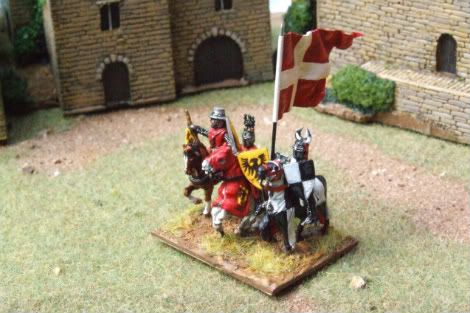
This is a picture from Villani. The picture is supposed to be of Heinrich IV, Emperor at the end of the 11th century, but is a better representation of an emperor in Villani's time - the early 14th century.

In DBA and DBM much of the German cavalry of this period is based with double depth. Various discussions on the TNE and DBMM groups suggests that this depth is not appropriate until later in the Middle Ages so the new Medieval German list is likely to lose 13th century double based elements. If it does, I shall probably rebase mine although I do like the look of them. Luckily I haven't many of them.
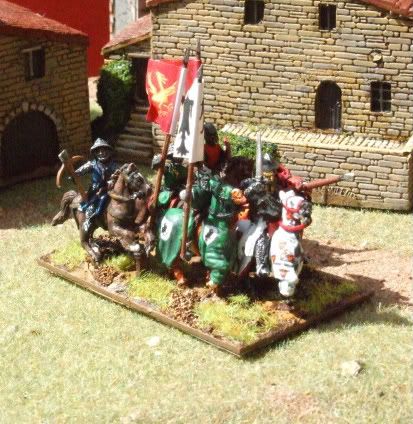
This represents the German mercenaries sent by Manfred of Sicily to support Siena against Florence in 1260. The story was that he initially only sent a small number with his banner (probably the eagle on white). The Sienese were dismayed by the small numbers but, according to Villani, they got the Germans drunk, promised them double pay and persuaded them to attack the Florentine camp. The Germans initially did well, catching the Florentines by surprise, but were eventualy overwhelmed and Manfred's banner was dragged through the dust back to Florence.
When Manfred heard about this he sent a further 800 knights to support Siena. One of these was Walter von Astimberg, who demanded that he be allowed to lead the charge against the Guelphs at Montaperti. The figure at the front shows him, followed by his wyvern standard. Note how the wyvern faces the flagstaff - arms on the reverse of flags were reversed like this. The figure carrying Manfred's eagle is based on one of the plates from the Manesse Codex, the opponent in this
plate.
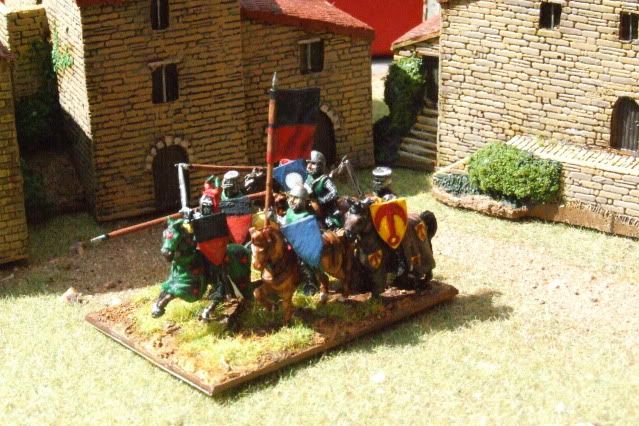
The leader of this group, Albrecht von Heigerloch, is again from the Manesse Codex. One of the interesting points in the
original plate is that the banner bearer holds the staff in his left hand, allowing him to wield a sword. Perhaps a figure manufacturer might oblige!
There is a problem with this paint job. Like many of the plates, the arms are shown as including black. I'd already noticed that arms I knew included white had black instead - apparently the colour had oxidized and there probably aren't many places in the Codex where black is right. However, I only recently thought to check this one and the Heigerloch arms should be white over red.Checking the plate, a couple of traces of white can be seen. I like the look of the red and black combo so may leave it, but it will nag at me!
The character at the rear with the very bucket shaped helm carries the arms of Frankenstein.
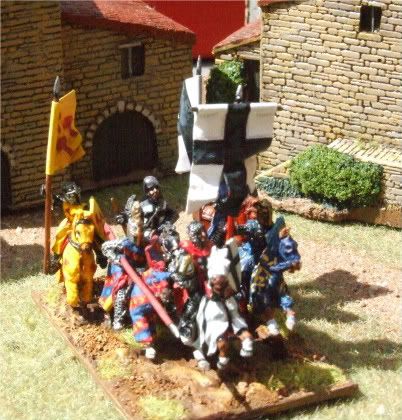
This is the Archbishop of Cologne with his standard bearer Adolf of Nassau, later King of the Romans. Adolf was the Archbishop's brother in law and carried his standard at the Battle of Woerringen.
The figure of the Archbishop is a slight conversion - I added a mitre made from Milliput to the top of his helm. The story of Medieval bishops avoiding the use of swords seems to have been apocryphal - there is a picture of the Bishop of Trier splitting a man's head in two with a sword in the pictures of Henry VII journey to Italy linked to above.






.jpg)







